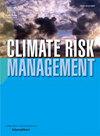作为沿海气候适应策略的浮式和架空结构:当地季风适应实践及其对洪水风险管理的影响
IF 5
2区 环境科学与生态学
Q1 ENVIRONMENTAL SCIENCES
引用次数: 0
摘要
通过使用浮动结构,将物理“推进”到水面上,是沿海地区一种新的气候适应策略。对海平面上升的担忧促使IPCC和联合国等国际组织探索这一先进战略。这些浮动结构(包括浮动建筑)作为一种适应策略的有效性取决于社会的接受程度。本研究通过系统回顾定性的历史和当前数据,对案例研究进行比较分析,以调查当地形式的适应知识。利用亚洲、非洲和南美洲部分地区的数据,通过全球季风系统的局部影响在概念上联系起来,它分析了使用本地设计在水面上或水面上的推进如何影响居民对水生环境的适应。它认为,尽管在环境上并不总是可持续的,但从历史上看,当地的船屋、漂浮结构和吊脚楼结构一直是一种常见的适应实践。乡土设计知识的案例研究支持了对转型沿海气候适应的先进战略的认真考虑。基于这些发现,文章进一步认为,虽然当地的吊脚楼结构为生活在水面上提供了优势,但与技术先进的浮动结构相比,技术先进的吊脚楼结构是不切实际的。关于这一主题的研究解决了文献中的一个空白,因为它将先进战略的白话和先进实施与沿海气候适应、白话适应知识和可持续的、社会接受的城市发展的新指导方针等蓬勃发展的跨学科领域联系起来。本文章由计算机程序翻译,如有差异,请以英文原文为准。
Floating and stilted structures as strategies in coastal climate adaptation: Local monsoon adaptation practices and implications for flood risk management
The physical “advance” onto aquatic surfaces through the use of floating structures is a new climate adaptation strategy for coastal regions. Sea level rise concerns have prompted international organizations like the IPCC and the UN to explore this advance strategy. The effectiveness of these floating structures, including floating buildings, as an adaptation strategy depends on social acceptance. This study applies a comparative analysis of case studies, identified through a systematic review of qualitative historical and present data, to investigate local forms of adaptation knowledge. Using data regarding parts of Asia, Africa, and South America, conceptually connected by the global monsoon system’s local impacts, it analyzes how advances onto or above aquatic surfaces using vernacular designs have affected inhabitants’ adaptation to the aquatic environment. It argues that vernacular houseboats, floating structures, and stilted (pile-elevated above the surface) structures have historically been a common, though not always environmentally sustainable, adaptation practice. The case studies of vernacular design knowledge support the serious consideration of the advance strategy in transformative coastal climate adaptation. Based on the findings, the article further argues that while vernacular stilted structures offer advantages for living on aquatic surfaces, their technologically advanced counterparts are impractical compared to technologically advanced floating structures. Research on this topic addresses a gap in the literature, as it connects vernacular and advanced implementations of the advance strategy to the booming interdisciplinary field of coastal climate adaptation, vernacular adaptation knowledge, and new guidelines for sustainable, socially accepted urban development.
求助全文
通过发布文献求助,成功后即可免费获取论文全文。
去求助
来源期刊

Climate Risk Management
Earth and Planetary Sciences-Atmospheric Science
CiteScore
8.20
自引率
4.50%
发文量
76
审稿时长
30 weeks
期刊介绍:
Climate Risk Management publishes original scientific contributions, state-of-the-art reviews and reports of practical experience on the use of knowledge and information regarding the consequences of climate variability and climate change in decision and policy making on climate change responses from the near- to long-term.
The concept of climate risk management refers to activities and methods that are used by individuals, organizations, and institutions to facilitate climate-resilient decision-making. Its objective is to promote sustainable development by maximizing the beneficial impacts of climate change responses and minimizing negative impacts across the full spectrum of geographies and sectors that are potentially affected by the changing climate.
 求助内容:
求助内容: 应助结果提醒方式:
应助结果提醒方式:


